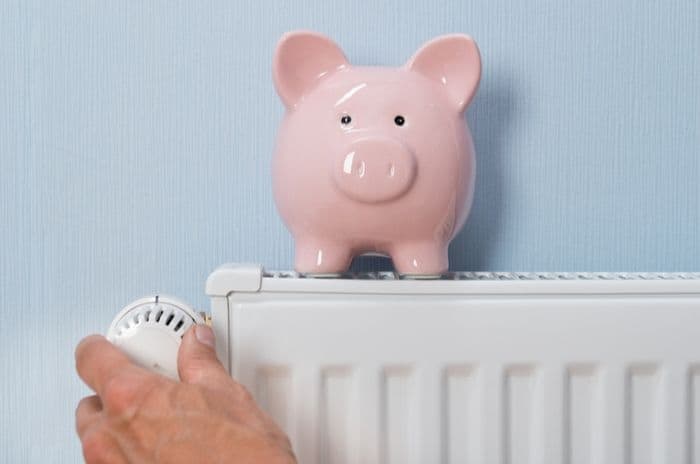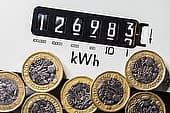When an energy supplier collapses, regulator Ofgem will step in to make sure a customer's energy supply is not disrupted.
Their rescue procedures are well-tested and mean that customers should sit tight and do nothing while they are being transferred to another provider.
All customers should take meter readings and keep records of their transactions to show to a new supplier if necessary.

What to do when your energy supplier goes bust
If an energy supplier collapses, customers should sit tight and do very little.
Thanks to Ofgem's protections, no home will lose their energy supply and all credit balances will be honoured by new suppliers.
Here are the things customers should do:
- Take meter readings for gas and electricity. Photos are useful as these can be used as proof in any later disputes. Sometimes outgoing suppliers will request these be inputted but, often, they won't be needed for a little while so keep them safe.
- Make a note of your credit balance via an online account (if possible) or by checking a recent bill. This is useful for a customer's own records so they know how much money is still on the account, but all credit balances are protected so don't worry if it can't be accessed.
- Check on this page or the Ofgem website to see which supplier has taken over. Appointing a new supplier can take anything from a few days up to a week, so don't worry if it isn't instantaneous.
And here are the things customers shouldn't do:
- Do not try to switch supplier. This can cause problems with Ofgem's automatic safety net procedures and may result in customer accounts getting lost in the system.
- Do not contact the existing (old) supplier for routine enquiries or to ask what's going on. They will be very busy and will probably be unable to answer questions anyway. Emergency calls if there's a problem with the supply might be acceptable but check the supplier's website for full information about who to contact.
While customers of failed suppliers are understandably anxious to find out what's happening, it's unfortunately a waiting game until a new supplier is appointed and things start moving again.
It can be frustrating but the best thing to do is nothing immediately after a collapse.
What happens next
Ofgem's Supplier of Last Resort (SoLR) process is triggered when an energy company collapses and the well-oiled process is designed to protect customers and ensure there is as little disruption as possible.
This is how the whole thing works from a customer's perspective:
- A supplier collapses and the SoLR process gets underway.
- Energy supplies continue as normal while Ofgem searches for a supplier to take over the failed company's customers. Direct debits will usually continue to be taken as usual.
- Ofgem appoints a new supplier.
- The new supplier contacts customers to explain they've taken over their energy supply and explain what will happen next. This will usually include timescales for credit balance refunds and how customers should get in contact if they need to.
- Customers will be asked for meter readings and credit balances returned.
Once the transfer process is complete, customers can switch to another supplier if they want to - although it won't always be a good idea depending on how high prices are and what choices are available on the market.
Find out more about how to switch energy supplier and what to expect.
Will energy prices go up?
Prices will usually go up when an energy supplier takes on the customers of a failed provider, although suppliers will sometimes put transferred customers on a special rate while they sort things out behind the scenes.
Price increases often happen because customers were paying less for energy with challenger suppliers and this cannot be sustained by their new supplier (more on this below).
As we mentioned above, customers can switch away once the SoLR process is complete, but that doesn't always mean there will be a better deal to be had.
Troubleshooting and FAQs
Energy customers are understandably anxious when a supplier collapses and the knowledge that their gas and electricity should be unaffected isn't always enough to put their minds at ease.
While Ofgem is going through the steps we've listed above, there are a few other things customers should be aware of.
How are new suppliers chosen?
Ofgem's tried and tested method for assigning a new provider takes place behind the scenes.
They first try to source a voluntary SoLR who is willing to take on a new batch of customers.
Ofgem prefer this voluntary system because it means the new supplier is completely committed to their new customers, although they will check whether the company has the capacity and resources to be an effective SoLR.
However, with the sheer number of suppliers who collapsed in 2021, some companies outright refused to be considered as SoLR for more customers because they didn't have the capacity to deal with them.
Ofgem also reserves the right to implement what's called a Special Administrator Regime (SAR) to protect customers when a big supplier falls as we saw when Bulb collapsed in November 2021.
This process is different but the central point is the same: a customer's energy supply will be protected.
Accessing account information
Ofgem acknowledges that an energy supplier may take their website services offline as soon as they collapse, meaning that customers are unable to access important information such as account balances and past meter readings.
As we've mentioned above, customers should take a meter reading as soon as possible but don't worry too much if they're unable to put that into the usual spot on their old supplier's website.
Instead, they should keep their own record of all the information they have on hand ready to give to the new supplier if they ask.
Behind the scenes, the collapsed supplier should give the SoLR all the information on meter readings and credit balances they need - getting in touch with either supplier will simply slow the process down for everyone.
Smart meters
Ofgem acknowledge that some smart meters won't function properly when customers are transferred to a new supplier.
This can happen if they're a SMETS1 old-style meter rather than a SMETS2 new-style meter that's connected up to a central network.
If this is the case, the meter can still be used as a traditional meter with customers required to supply meter readings in the old-fashioned way.
Ofgem say meters are likely to be able to work again in the future when all meters are enrolled on the central network or when a customer switches to another supplier who can handle their meter, but that doesn't much help customers who have been using a smart meter previously and find themselves going back to manual readings.
SEG and FIT
Customers with Smart Export Guarantee (SEG) tariffs or Feed-in Tariff (FIT) customers will need to find a new supplier to continue with their electricity exports.
SEG customers are responsible for finding another SEG Licensee from the 12 companies required to offer them and the few voluntary licensees on the market.
It's important for SEG customers to act quickly since any new SEG Licensee is only required to make payments from the start of any agreement - nothing will be backdated and so customers may be missing out on export cash.
Similarly, if a customer's new supplier is not a FIT licensee, they will need to seek one out. Even if the new supplier does hold a FIT licence, the payments won't automatically transfer and customers will need to engage with their new supplier to iron out the details.
What if I have a prepayment meter?
Customers with prepayment meters should see no immediate difference to the way they top up their energy.
As we've discussed with post-payment meters above, anyone with a pre-payment meter should continue to pay for their supply in the same way as they usually do.
However, while Ofgem's official guidelines for post-payment meters says supply 'won't be disrupted', the wording for pre-payment customers is slightly woollier and says customers 'shouldn't lose supply'.
It seems they're covering themselves here because of the issues that can occur with pre-payment meter top ups and they say that customers who are having issues with topping up should contact one of the following organisations:
- Citizens Advice
- Advice Direct Scotland (for those in Scotland)
They advise contacting the same organisations in the following circumstances:
- If the prepayment meter stops working and they have no power
- If they need a new prepayment meter key card or token
- If they can't afford to top up their prepayment meter and need emergency credit
So, while Ofgem is optimistic that prepayment meter customers won't have issues with the switchover, their guidance directs them to another organisation if a problem does crop up.
The good news is that almost all energy suppliers have a prepayment tariff available, meaning customers with that type of meter should be able to continue on a prepayment tariff when they are switched to a new company.
What if I'm moving home?
Anyone moving home while Ofgem are in the middle of their SoLR procedures might find that things get a little confusing but customers can reduce the potential impact by keeping accurate records.
As always when moving home, energy customers should take meter readings for their old property and their new home on the day they move out/in.
Ofgem advise that customers redirect post from their old address to their new one to allow their new supplier (or administrator) to contact them about their account and any credit balance.
The reasoning behind this is that trying to process a change of correspondence address while a company in the middle of collapsing might be difficult but it does put a financial burden on the customer.
At the time of writing, it costs around £34 for a three-month postal redirect from Royal Mail to another property in the UK with a six-month redirection costing £48.
While many customers would want a postal redirect when they move anyway, there will be some customers who weren't planning on implementing one and may find it frustrating that the collapse of their energy supplier is essentially forcing them into it.
If a customer moves into a property where the energy supplier has recently collapsed, Ofgem's guidance is the same as above: take a meter reading but otherwise do nothing else until a new supplier contacts the address.
For customers who simply want to get their bills in order at their new address, this can be irritating and we'd advise putting money aside to deal with the energy bills when they eventually appear.
Outstanding complaints
If a customer has a complaint outstanding with an energy supplier when they collapse, the act of the supplier collapsing may end the complaints process.
Suppliers who take on the customers of another company are not required to take on their complaints too. However, Ofgem encourages customers who still think their complaint is unresolved to discuss it with a new supplier when they take over.
Again, this advice is woolly and it remains unlikely a new supplier is going to take on responsibility for mistakes made by another provider.
For customers who had already escalated a complaint to the Ombudsman, they will be contacted directly by the Ombudsman to discuss what happens next.
Find out more about making an energy complaint and what happens when you do.
Conclusion: Do nothing
An energy supplier collapsing can be a stressful period for customers who aren't sure what happens next and can't get in touch with their supplier to find out.
The good news is that post-payment customers won't see any disruption to their supply and there are helplines available for prepayment customers who run into difficulty.
Ofgem's advice to sit tight and wait for their rescue process to run its course can be frustrating, especially if customers are moving home or they have credit balances they want returned.
However, getting in touch with collapsed suppliers or new providers can slow things down for all customers and it's unlikely to resolve things any faster than waiting for the new provider to get in touch.
Energy companies took on over 4.2 million customers from failed suppliers in 2021. That's a lot of administration for those firms and it's unavoidable that some customers will have been unhappy with the way the transfers occurred and how the process was handled.
For customers with ongoing issues, our guide to your energy rights may be useful.








